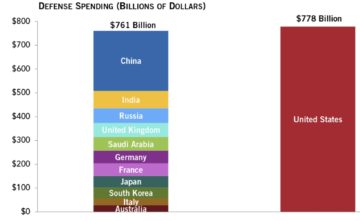Phillip Meylan in The Factual:
 The state of U.S. defense spending is often boiled down to eye-catching but incomplete statistics. On one side, the U.S. spends more than the next 11 nations combined, amounting to a grand total of 38% of defense spending worldwide, three times more than China, and ten times more than Russia. Conversely, defense spending as a percentage of GDP is at one of the lowest points since World War II, at somewhere between 3 and 4 percent. Depending on who you ask, the U.S. is either at risk of being unable to cope with 21st-century security challenges, including from actors such as China and Russia, or wasting money hand over fist on unproven, outdated, or irrelevant platforms.
The state of U.S. defense spending is often boiled down to eye-catching but incomplete statistics. On one side, the U.S. spends more than the next 11 nations combined, amounting to a grand total of 38% of defense spending worldwide, three times more than China, and ten times more than Russia. Conversely, defense spending as a percentage of GDP is at one of the lowest points since World War II, at somewhere between 3 and 4 percent. Depending on who you ask, the U.S. is either at risk of being unable to cope with 21st-century security challenges, including from actors such as China and Russia, or wasting money hand over fist on unproven, outdated, or irrelevant platforms.
Proponents of maintained or higher spending often focus on a rising threat from China and Russia and see maintaining a military superiority as a buttress against global authoritarian powers. Through the maintenance of a military advantage, they argue the U.S. can deter aggression, or win a conflict if required. The current invasion of Ukraine by Russia is a prime example of such a security concern, though the U.S. military seems unlikely at this point to become formally involved. Those in favor of lower defense spending often see concerns about rising authoritarian powers as issues that can be solved at the negotiating table, with the cooperation of allies and partner forces, or, if need be, with a more limited military. Rather than indispensable military capabilities, critics often see bloated spending on ineffective, unproven, or irrelevant platforms.
More here.
